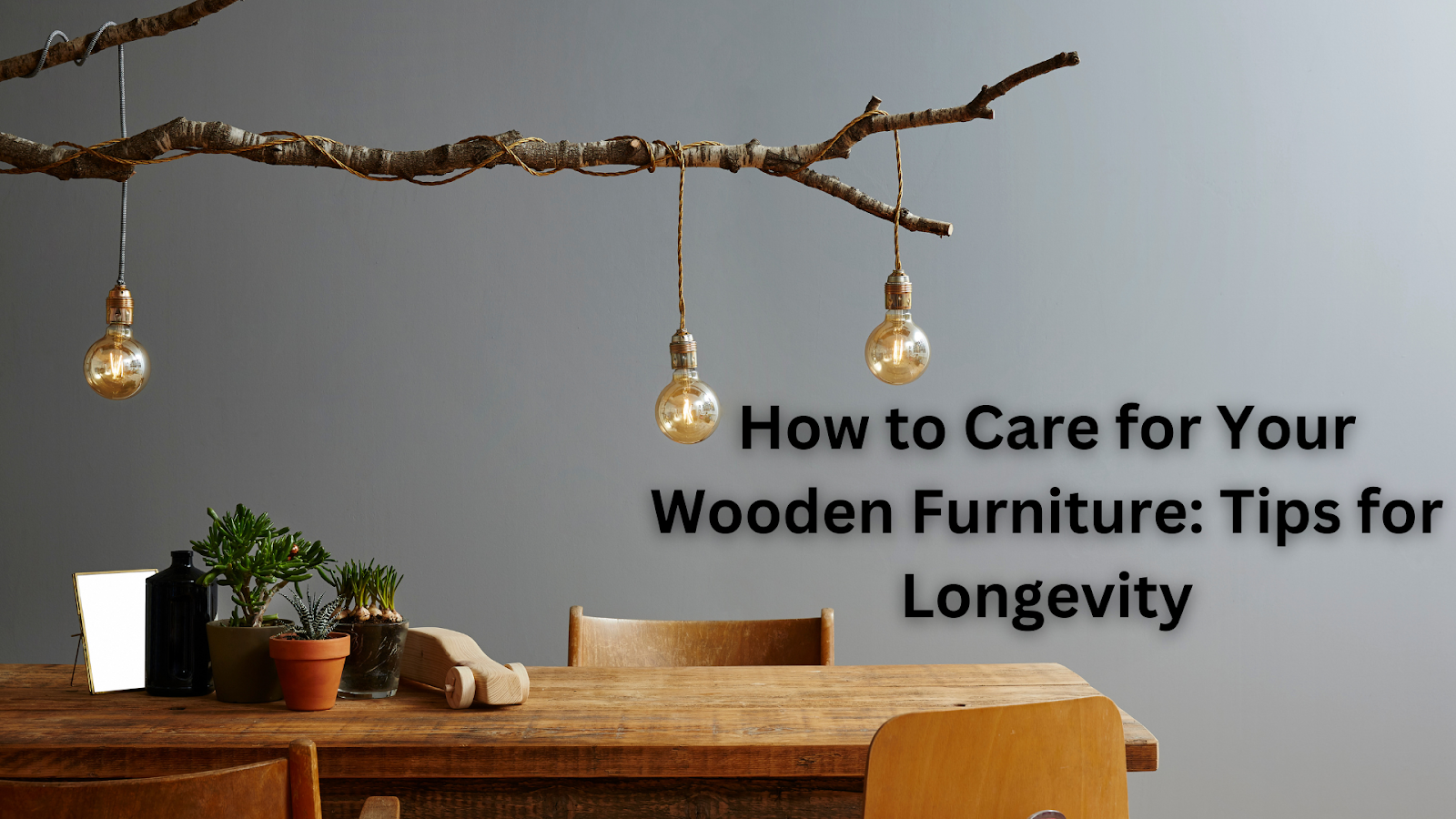Are you wondering how to keep your wooden furniture looking as stunning as the day you bought it? Whether you own a treasured antique piece or sleek modern wooden furniture, proper care is key to preserving its charm and durability.
| Did you know? The largest segment within the market is living room furniture, which is projected to have a market volume of US$73.08bn in 2024. |
Wooden furniture adds warmth, elegance, and charm to any home. To ensure your cherished pieces last for generations, proper care is essential.
In this blog, we’ll share practical tips for maintaining your wooden furniture, so it remains as stunning as the day you bought it.
Evaluating the Condition of Your Wooden Furniture
Type of Wood and Finish
Different wood types and finishes require specific care approaches. Common wood types used in furniture include oak, maple, pine, cherry, mahogany, and walnut. Knowing your furniture’s wood type and finish will guide you in choosing the right cleaning products and maintenance techniques.
Identify Signs of Damage
Inspect your furniture for:
- Cracks: Resulting from humidity or temperature changes.
- Discoloration: Caused by sunlight or chemicals.
- Scratches: Surface marks affecting appearance.
- Watermarks: Rings left by moisture.
When assessing your wooden furniture, consider the local environmental factors. In Austin, Texas, the humid subtropical climate can lead to wood expanding and contracting, potentially causing warping or cracking.
The intense Texas sun can also fade and dry out wood over time. For those living in or near the area, furniture stores near Austin, TX can often gain insights on protecting wooden pieces from these climate conditions. Regular assessment and appropriate care can help mitigate these effects and preserve your furniture’s beauty.
Prioritize Repairs
First, identify any damages and make repairs. Small scratches and watermarks can easily be repaired at home, while larger issues will require a professional. You evaluate your furniture to take the right measures toward its maintenance, which can extend its life.
Optimal Methods for Cleaning Wooden Furniture
Proper dusting of wood furniture will maintain its appearance and longevity. Soft, lint-free cloths made of microfiber are best for dust removal since such cloths will not scratch the surface. For effective dusting, slightly dampen the microfiber cloth, and always dust in the direction of the wood grain to avoid damage. Special attention to intricate designs and crevices is important since this is where dust loves to collect.
For dust or grime that is more persistent, cleaning solutions that won’t damage the wood should be used. Harsh cleaners and those containing water will strip the finish of its natural oils. A soft cleaning solution of mild dish soap and warm water would work best when cleaning wood surfaces. Make sure to test the solution on a small, hidden area first.
Another important procedure for maintaining wooden furniture is regular polishing. Polishing allows the natural luster of the wood to come through, fills minor scratches, and protects the surfaces against dirt and moisture. Use polish intended for wood and apply it in the direction of the grain for best results.
Protecting Wooden Furniture from Environmental Damage
Environmental factors can significantly impact the condition of your wooden furniture. By taking proactive steps to protect your pieces from these elements, you can extend their lifespan and maintain their appearance.
Keep Furniture Out of Direct Sunlight
Exposure to direct sunlight for extended periods can cause significant damage to wooden furniture. Ultraviolet (UV) rays can fade wood finishes, leading to discoloration and potential weakening of the wood structure.
Tips to protect from sun damage:
- Rotate furniture periodically to ensure even exposure
- Use window treatments, such as curtains or blinds, to filter sunlight
- Apply UV-resistant finishes or sealants to outdoor wooden furniture
Control Humidity Levels
Fluctuating humidity levels can cause wood to expand and contract, potentially leading to warping, cracking, or loosening of joints. Unsealed wood is particularly susceptible to these issues.
The ideal humidity levels for wooden furniture are:
- Indoor humidity: Maintain between 35-45
- Use a hygrometer to monitor humidity levels in your home
Consider using a dehumidifier in damp areas or a humidifier in dry climates to maintain optimal conditions for your wooden furniture.
Use Protective Pads and Coasters
Simple preventive measures can go a long way in protecting your wooden furniture from daily wear and tear.
Protective measures to implement:
- Place coasters under each glass and cup to catch water rings.
- Use placemats or tablecloths for meals to catch spills and prevent scratching.
- Put felt pads on the bottom of ornaments and other objects to prevent scratching of either floor when shifting them.
Applying Protective Coatings and Sealants
To protect and enhance the durability of your wooden furniture, applying protective coatings and sealants is essential. These products create a barrier against moisture, UV rays, and daily wear, helping to preserve the wood’s natural beauty.
Reapply Finishes or Sealants
For indoor furniture, reapply every 3-5 years, while outdoor pieces may need it annually. Varnished or sealed furniture is low maintenance but requires periodic renewal to prevent wear.
Selecting the Right Products
Choose oils, waxes, or varnishes that suit your furniture’s finish:
- Oils (e.g., tung oil): Deep protection, enhances grain.
- Waxes (e.g., beeswax): Lustrous finish, moisture protection.
- Varnishes/Lacquers: Hard, durable protection against scratches.
Application Process
Ensure the furniture is clean, lightly sand if needed, and apply in thin coats. Test the product first and allow each coat to dry fully before applying the next. Proper ventilation is important when using products with VOCs.
Repairing Common Damage
Even with the best care, wooden furniture can sometimes get damaged. Addressing these issues quickly can prevent further deterioration. Here’s how to fix common problems:
Minor Scratches
- Furniture touch-up markers: Use to conceal small scratches.
- Wood filler: Fill deeper scratches, then stain to match the wood.
- Walnut method: Rub the meat of a walnut over the scratch to fill and disguise it.
Watermarks
- Baking soda paste: Mix baking soda with water, rub gently on the watermark, and wipe clean.
- Non-gel toothpaste: Apply a small amount, rub gently, and wipe off.
- Iron method: Place a cloth over the mark, then run a warm iron over it to draw out the moisture.
Deeper Cracks or Chips
- DIY fix: Clean the area, apply wood filler or epoxy, sand smooth once dry, then stain or paint to match.
- For antiques or complex repairs: Consider consulting a professional to avoid further damage.
Long-Term Maintenance and Care
Just cleaning and, from time to time, making repairs is not enough to maintain your wood furniture over a long period. It is very important to apply the ultimate care routine to keep your pieces beautiful and functional.
One of the most key practices of moving furniture periodically is to distribute wear and tear uniformly so that there won’t be any uneven fading. This is especially important for items exposed to sunlight or placed in high-traffic areas.
Other factors also call for regular inspections. You would want to inspect your outdoor furniture for loose joints, pest damage, or weather-related wear so that you may take measures against a potential problem before it becomes serious.
Not to be forgotten is storage: wooden furniture should be stored in climate-controlled areas, wrapped in breathable materials, and kept off the ground to prevent water damage. Disassembly of larger pieces can help minimize joint stress during storage.
Final Thoughts
Caring for your wooden furniture is an investment in the beauty and longevity of your home decor. Whether it’s your outdoor wooden furniture, rustic wooden furniture, or modern wooden furniture piece, by following these cleaning, protection, and maintenance tips, you will be able to keep it gorgeous and functional for a long time.
FAQs
How can I make my wood furniture last longer?
Clean it regularly; polish it and protect it from sunlight and water. Small damage, before it gets worse, should be repaired.
How can I improve the life of my wooden furniture?
Use furniture rotation, proper humidity, and protection pads or coasters to avoid wear and tear.
How can I increase the lifespan of wood?
Treat the wood with protective coating, stay away from extreme elements of weathering, and also frequently carry out maintenance like polishing and inspection.



